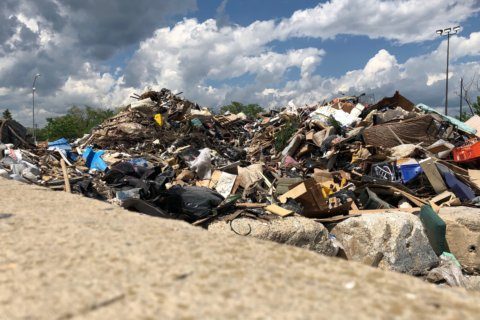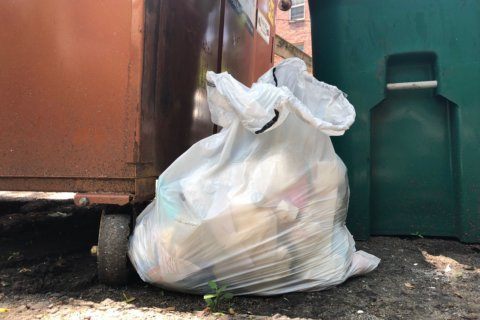How much trash do we throw away? How does recycling work? What, even, is compost? TRASHED is a three-part series that looks at the state of waste in the D.C. region and the options local experts are exploring to cut down on the amount of trash that’s piling up.
When you think about the trash that sits in a landfill, what comes to mind? Broken furniture? Empty chip bags? Plastic for days?
You’ll find those things. But you’ll also find a whole lot of food.
More food ends up in landfills and incinerators than any other single material in our everyday trash, according to the U.S. Environmental Protection Agency. The latest data available, from 2015, show nearly 40 million tons of food was thrown away that year — up from about 13 million tons in 1960.
And food in landfills is far from harmless: Water from spoiled leftovers mixes with chemicals from other trash and creates a chemical “soup” called leachate, which has to be captured and treated separately. Plus, as food breaks down, it creates methane — “And methane is at least 25 times more potent than carbon dioxide as a greenhouse gas,” said Cathy Plume, vice chair of the D.C. chapter of the Sierra Club.
The EPA reports landfills are the third-largest source of human-related methane emissions in the United States. “So by keeping that food waste out of the landfill, you’re creating a cleaner environment,” Plume said.
Reducing food waste is a top-of-mind topic across a number of industries in the U.S., where 30% to 40% of all food is wasted. Restaurants are designing menus around previously trashed ingredients, and entrepreneurs are building businesses that rescue and resell “ugly” produce. Environmental leaders are also working on the issue — especially in the D.C. area.
Making compost mainstream
The D.C. region is home to some programs that successfully encourage residents to reduce their trash by removing food from the waste stream. Prince George’s County, Maryland, is a prime example with its curbside composting pilot and large composting facility, which processes more than 50,000 tons of material each year.
Yet other jurisdictions in the area face an uphill battle when it comes to changing residents’ habits and getting initiatives off the ground.
Two years ago, D.C. launched a food waste drop-off program that allows residents in all eight wards to take their scraps, peels and coffee grounds to designated farmers markets, where they are turned into compost for free. (Compost is organic matter made from decomposed materials that is rich in nutrients and serves as a soil conditioner. In other words, it’s really good for the garden.) It’s one way D.C. is working toward its goal of 80% waste diversion. Currently, the District diverts 23% of its trash from the landfill.
Annie White, who heads up the Office of Waste Diversion at D.C.’s Department of Public Works, said the program has been successful thus far, and could serve as a model for an expanded curbside collection, which the city is currently exploring.
“In the past year, food waste collected has grown by 400 percent,” said White, who estimates about 1,500 households participate in the District’s drop-off program each weekend.
“We’re doing some outreach and education, but it’s kind of growing exponentially on its own.”
Fifteen hundred households may sound like an impressive level of participation, but it’s fewer than 1% of the the nearly 278,000 households in the District.
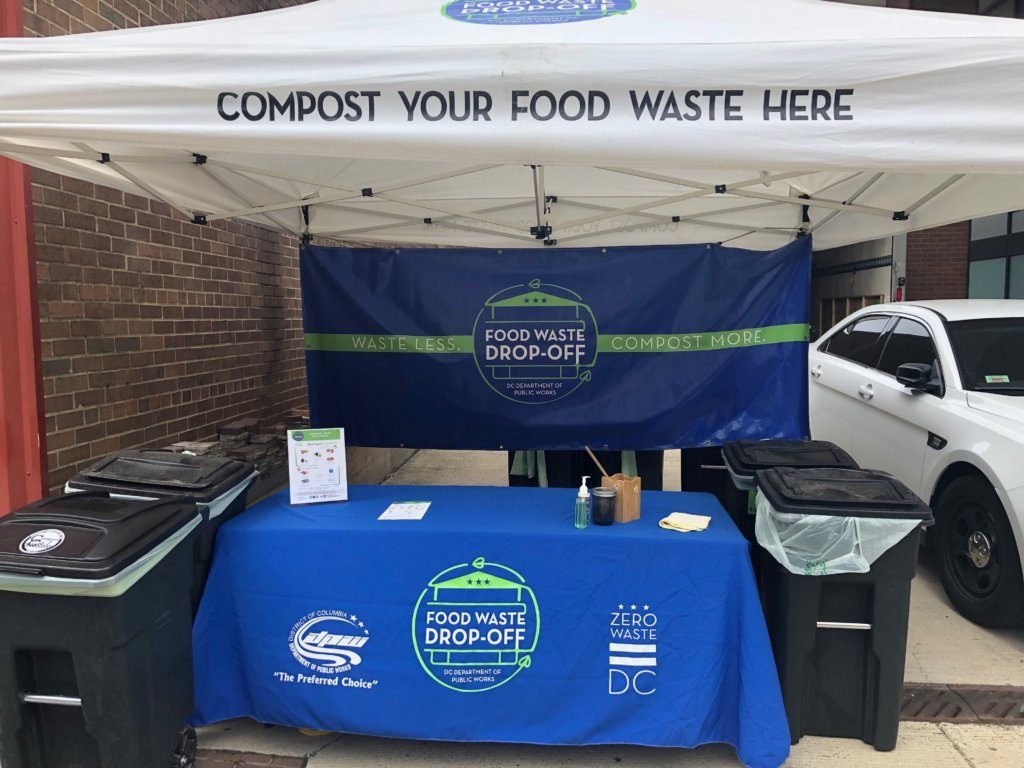
D.C. Council member Mary Cheh said that in order to take the program from a drop-off design to curbside collection, the city needs to invest in infrastructure.
“We have to have a place to put all of this composting,” said Cheh, who added that D.C. currently utilizes small compost centers around the city, as well Prince George’s facility, but would benefit from having its own.
The District’s 2021-2022 budget includes $8 million for construction of a composting facility. “And we have to find a place to put it,” Cheh said.
A curbside program also needs trucks, as well as cooperation from multi-unit buildings and businesses that contract with private haulers.
In 2015, Prince George’s County, Maryland, reported a waste diversion rate (the amount of trash kept from going to the landfill) of 64.59%. Adam Ortiz, who led the Prince George’s County Department of the Environment from 2012 to January 2019, said composting helped to make the county No. 1 for waste diversion in Maryland. (For comparison, Montgomery County, Maryland’s reported waste diversion rate is 62%; Arlington, Virginia’s rate is just under 50%.)
Now, Ortiz is the director of Montgomery County’s Department of Environmental Protection, and he’s hoping to make a similar impact on its efforts, where 147,000 tons of food waste was generated in 2015.
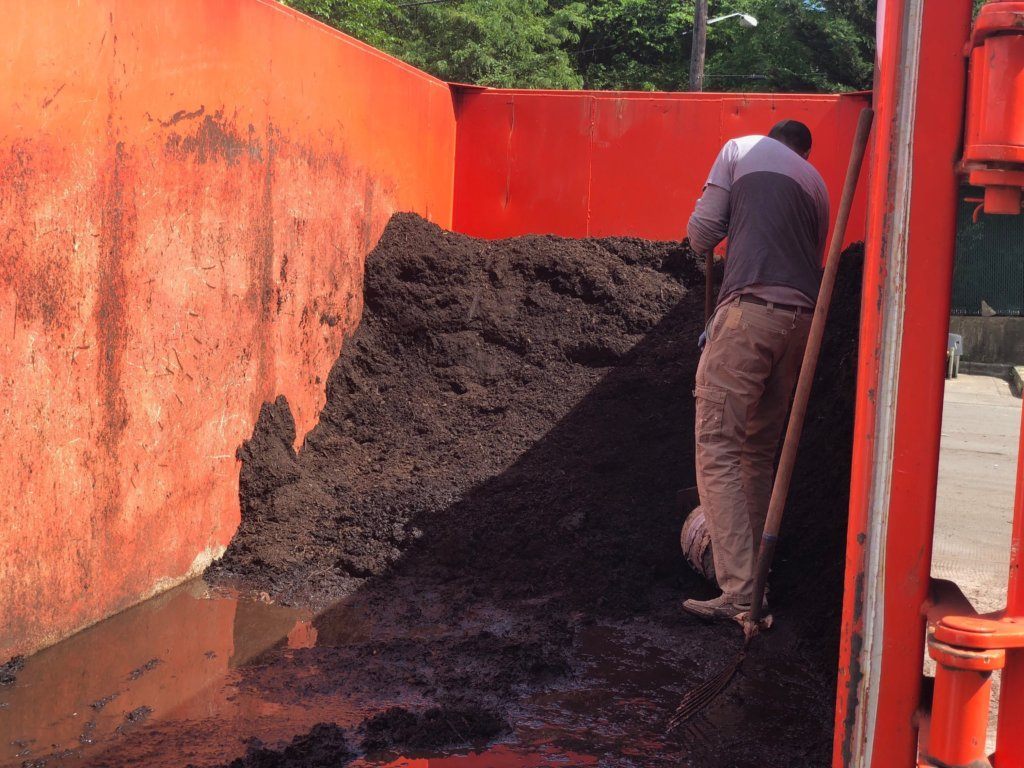
“With all the restaurants that we have and all the distributors and supermarkets, there’s a great opportunity to capture [food waste], so that’s a big focus of the [County Executive Marc] Elrich administration, and my work in particular,” Ortiz said.
While any resident can do backyard composting, Ortiz said, government-run curbside programs encourage more composting participation, especially from those “who are a little uneasy or don’t need another chore to do on a Saturday afternoon.”
“And I think that’s the future,” Ortiz said. “And in the right kind of container, it’s not any different than putting out your trash.”
Across the Potomac River in Arlington, Virginia, Solid Waste Bureau Chief Erik Grabowsky said “food is the next big thing” in the county’s plan to reduce trash. He estimates food makes up about 25% of the materials in its trash bins.
Arlington residents can drop off their food scraps at a county-run collection bin, where they are processed on site and used for landscaping projects throughout the area. The county, which already collects and composts yard waste, also sells food composting bins to residents at a below-market rate, but so far, there is no curbside collection for food scraps.

Grabowsky said the county’s contract would allow for a curbside program, where food scraps would be collected in the same bin as grass clippings, leaves and other yard waste — but Arlington isn’t there quite yet.
“What we’ve been partly waiting for is the infrastructure. There hasn’t been a facility open yet that manages organics and food waste together,” Grabowsky said.
A lack of curbside composting programs in the region hasn’t stopped Washingtonians from keeping food scraps out of the landfill, however. Many use private services such as The Compost Crew — a company started by two Bethesda, Maryland, natives in 2011 that collects food waste and other organic materials from individual houses, schools, museums and more throughout the area for a fee that ranges from $16 to $32 a month.
Ryan Walter, president of The Compost Crew, said he looks at food scraps like a commodity that can be recycled into a high-quality product and sold to landscapers and farmers. And over the last eight years, business has been good.
“I think growth and interest in this area has been really staggering,” Walter said. “I feel like [composting is] where recycling was maybe 10 or 20 years ago, it’s just going to be a third bin, it’s going to be part of our culture.”
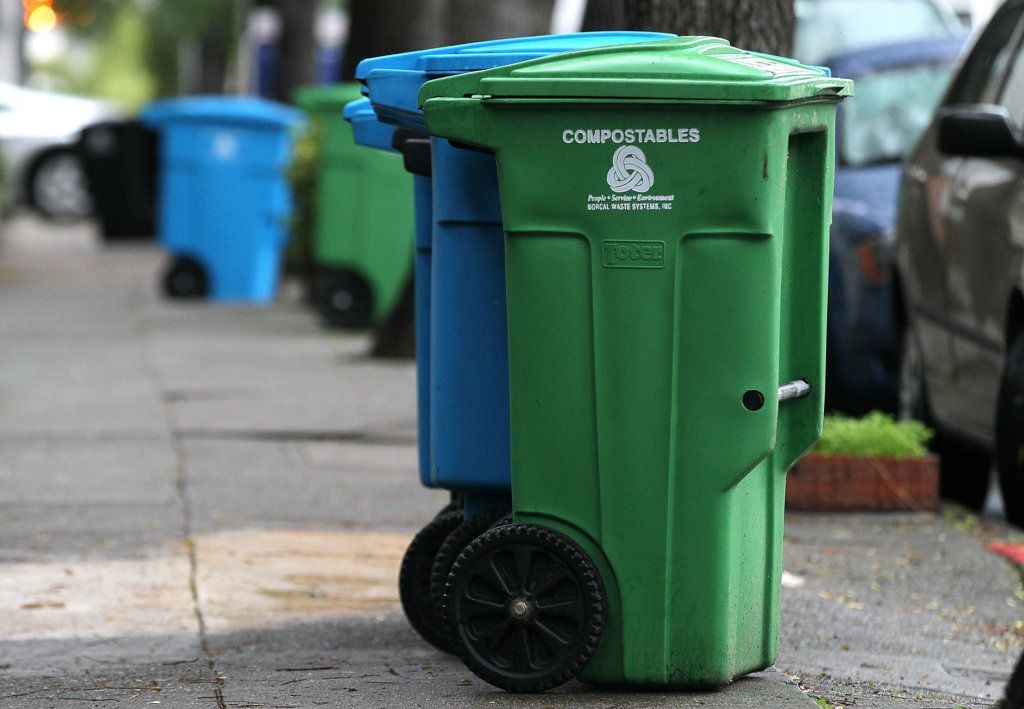
While diverting food from the waste stream will have an impact on the amount of material sent to landfills and incinerators, activists say it’s not the single answer that’s going to push the region toward “zero waste.”
“Getting food waste out of the waste stream, alone, that’s not going to get us to 80 percent diversion,” said Plume, who is based in D.C. “There’s a lot more that has to happen.”
How to reduce food waste at home
Want to cut down on the amount of food that ends up in your trash can? Here are some tips:
1. Buy less. Loading your shopping cart up with fresh fruits and vegetables is not a bad thing, but buying more than what you’ll realistically eat leads to waste. A recent study found Americans throw out about a pound of food each day, so just buy what you know you need.
2. Salvage small amounts of leftovers. Only using half the can of tomato paste? Still have some stock left over that could enhance the flavor of a future soup? Fill an ice cube tray with odds and ends, pop it in the freezer and use them when you need them.
3. Get creative in the kitchen. Carrot tops and kale stems don’t have to get tossed. Incorporate them into new recipes, such as kale stem pesto or potato peel chips.
4. Sell-by dates are trash. Nine out of 10 Americans throw away food that’s perfectly fresh because of the expiration date, according to a study conducted by the National Resources Defense Council and the Harvard Food Law and Policy Clinic. Obviously, perishable foods have a shelf life, but use common sense (and your senses) before you toss that yogurt. A Maryland family recently lived on expired food for a year. The USDA’s Safe Food Handbook is another helpful resource.
5. Compost, even if you don’t have a yard. You don’t need land to compost your kitchen scraps. D.C. and many of the surrounding jurisdictions have drop-off centers where residents can take their compost. A neighbor might also be interested in taking your food scraps to enrich their garden.
6. Worried a bin of banana peels will stink up your house? Keep your scraps in a sealed bag in the freezer until you’re ready to drop them off.
Compost drop-off centers
- Click here for D.C.’s list of food-waste drop-off centers. D.C. residents can also pick up free compost for their gardens at the Fort Totten Transfer Station.
- In Arlington County, residents can bring their food scraps to 4300 29th St. South, Monday through Friday from 5 a.m. to 9 p.m. and Saturdays from 6:30 a.m. to 6 p.m.
- Alexandria also has drop-off centers for compost at its farmers markets.
- Residents in Prince George’s County can take their compost to the county’s organics composting facility.

